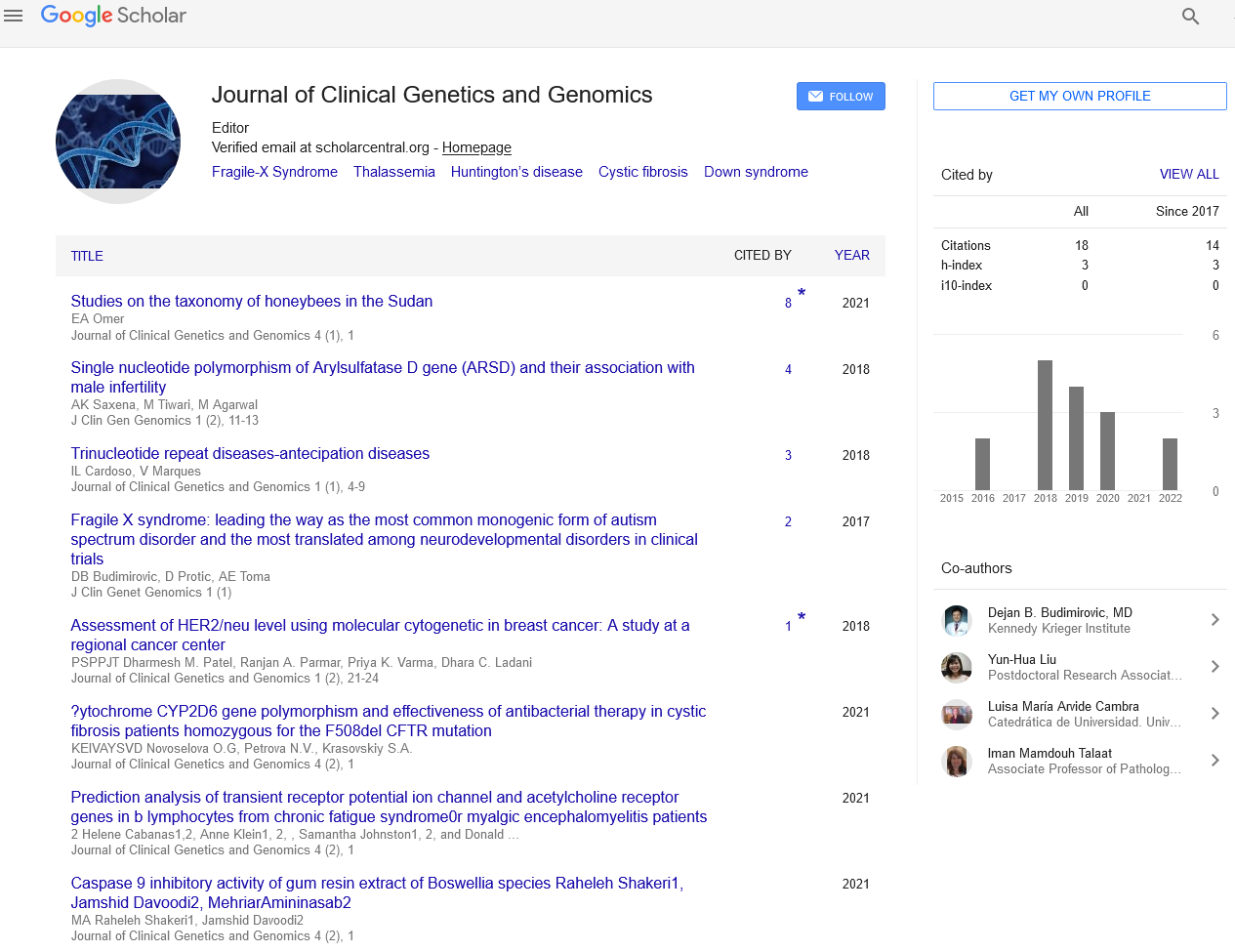Partial monosomy 21 mirrors trisomy 21 gene expression in a neuroepithelial stem cell culture obtained from a patient
Received: 06-Apr-2022, Manuscript No. PULJCGG-22-5785; Editor assigned: 08-Apr-2022, Pre QC No. PULJCGG-22-5785 (PQ); Accepted Date: Apr 17, 2022; Reviewed: 12-Apr-2022 QC No. PULJCGG-22-5785 (Q); Revised: 15-Apr-2022, Manuscript No. PULJCGG-22-5785 (R); Published: 20-Apr-2022
Citation: Howell J. Partial monosomy 21 mirrors trisomy 21 gene expression in a neuro-epithelial stem cell culture obtained from a patient. J. Clin. Genet. Genom. 2022;5(2):1-2.
This open-access article is distributed under the terms of the Creative Commons Attribution Non-Commercial License (CC BY-NC) (http://creativecommons.org/licenses/by-nc/4.0/), which permits reuse, distribution and reproduction of the article, provided that the original work is properly cited and the reuse is restricted to noncommercial purposes. For commercial reuse, contact reprints@pulsus.com
Abstract
Patients' Induced Pluripotent Stem Cells (iPSCs) are a desirable disease model for researching tissues that are difficult to access, such as the brain. We and others have demonstrated that trisomy 21 causes genome-wide transcriptional dysregulations using this method. On chromosome 21, the consequences of gene deletion are substantially less well understood. Here, we employ ring chromosome 21 with two deletions spanning 3.8 Mb at the terminal end of 21q22.3, encompassing 60 protein-coding genes, and patient-derived brain cells from a person with neurodevelopmental delay. We developed patientderived iPSCs from fibroblasts that still had the ring chromosome 21 and then converted those iPSCs into neuroepithelial stem cells to examine the molecular effects of the partial monosomy on neural cells. When compared to euploid NESCs, RNA-Seq study of NESCs with the ring chromosome indicated downregulation of 18 genes in the deleted region as well as overall transcriptome dysregulations. We also compared the dysregulated transcriptome profile with that of two NESC lines with trisomy 21, since the deletions on chromosome 21 indicate a genetic "contrary" to the trisomy of the homologous locus. 23 genes on chromosome 21 as well as 149 genes not on chromosome 21 had opposing expression changes, according to the research. Together, these findings shed light on how a partial monosomy of chromosome 21qter during early neuronal differentiation affects both global and chromosome 21-specific gene expression.
Key Words
Neurodevelopmental; Downregulation;Transcriptome; Neuroepithilial; Dysregulations
Introduction
The smallest human chromosome, Chromosome 21, contains only 237 protein-coding genes. Although trisomy 21 is the most frequent chromosomal anomaly, monosomy of chromosome 21 is not compatible with life and occurs in 0.152% of live births. While trisomy 21 is uncommon, partial deletions of chromosome 21 have been observed, and these people frequently exhibit developmental delay, delayed motor function, and develop cardiac problems. The size, location, and particular genes affected by the deletion will all affect the clinical appearance of a partial monosomy. The chromosomes may become unstable when deletions are present in or within the subtelomeric regions, encouraging rescue through chromatin fusions that result in chromosomal circularization and the creation of a ring chromosome. According to reports, ring chromosomes spontaneously appear in newborns at a rate of 1: 50,000 and frequently contain other structural genomic abnormalities, including telomeric deletions, inversions, or duplications. The hallmark characteristics of a proband carrying ring chromosomes, sometimes referred to as "ring syndrome," include a variable degree of growth failure, intellectual disability, and developmental delay. Although there is a wide phenotypic spectrum, ranging from completely healthy to severe paediatric diseases, the phenotypic effects of a particular ring chromosome may differ because the rearranged chromosome is unstable and might cause new genomic abnormalities. As a result, the precise clinical manifestation of the carriers will depend on the interaction between gene loss or gain and the dynamics of the ring chromosomal shape.
Using RNA-Seq is a great way to examine changes in gene expression across the entire genome and gain understanding of complex dysregulations brought on by structural differences. It is crucial to look at gene expression in disease-relevant cells because many genes are not expressed in all tissues. Given the limited availability of post-mortem brain biopsies, this presents a particular challenge for genes expressed in neural tissue. Additionally, the transcriptome profiles of simpler tissues, such as blood or fibroblasts, cannot be compared to those of brain cells. Somatic cells may be converted into induced pluripotent stem cells to restore a pluripotent state and then differentiate into neuronal cell types to get around this problem. The data from any RNA-Seq experiment will only include transcripts from expressed genes. As a result, if an inappropriate cell type is utilised, relevant expression modifications will be overlooked. In the current study, we modelled early neural development in a clinical case with neurodevelopmental delay and a partial monosomy of chromosome 21 using iPSC-derived neuroepithelial stem cells (NESCs). In addition to corresponding euploid cells and cells with a full trisomy 21, we also examined the transcriptome profile of NESCs with ring chromosome 21. Here, we show the effects of monosomy on 60 genes on chromosome 21q4 across the entire genome. The patient, RD P26, was the second kid born to Swedish-born, healthy, non-consanguineous parents. The pregnancy went off without a hitch, and although she was delivered at term, a second ultrasound was done because of concerns about her growth. Birth length was 48 cm (1 SD), birth weight was 2780 g, and head circumference was 32 cm. A preauricular appendage on the right ear, hemifacial microsomia, feeding issues, speech delay, postnatal growth delay (2 SD for both length and weight), and feeding issues led to the girl's initial referral for genetic testing at age 2 years and 7 months.





